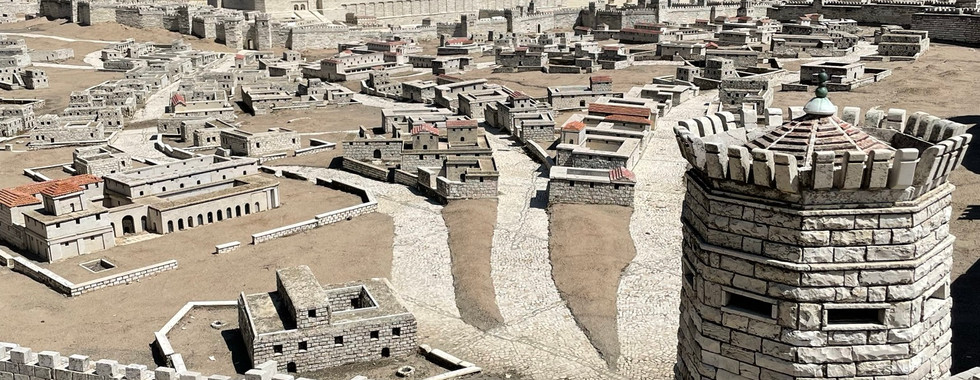My Visit to The Israel Museum in Jerusalem: Reflecting on History and Heritage
Jerusalem, Israel ✈

During these challenging times when Israel is combating terrorists trying to end its existence and simultaneously fighting for the survival of the free democratic world, it feels particularly poignant to reflect on my recent visit to The Israel Museum in Jerusalem.
The first time I visited the museum was during a family trip when I was 13 years old, the summer after my bar mitzvah. It was nice to revisit the museum and view it with an adult perspective.
The museum, a beacon of culture and history, stands as an example of the resilience and rich heritage of a nation that has weathered many storms. My time there was not just an exploration of art and antiquities but also a journey through the enduring spirit of Israel and its people.
It's in moments like these that we realize the importance of such cultural institutions, reminding us of the depth and complexity of human history and the unyielding hope for a peaceful future.
Book a Tour: Top Israel Tours
“The Israel Museum in Jerusalem is a treasure trove of art, history, and culture.”
The Israel Museum:
The prestigious Israel Museum, established in 1965, is not only Israel's largest cultural institution but also ranks among the world's leading encyclopedic museums.
Location and Architecture:
Located on a hill in the Givat Ram neighborhood of Jerusalem, the museum's location is strategic, lying adjacent to significant landmarks like the Bible Lands Museum, the Knesset, the Israeli Supreme Court, and the Hebrew University of Jerusalem. Its architecture is noteworthy, with masonry buildings designed by the Russian-born Israeli architect Alfred Mansfeld. A significant renovation in 2010, led by Israeli architects Efrat-Kowalsky Architects, expanded and modernized the museum, linking the original structures through a new entrance pavilion and creating additional pavilions designed by James Carpenter.

Collection and Exhibits:
The museum's extensive collection, numbering nearly 500,000 objects, ranges from prehistoric times to the present day. This diverse collection represents a broad spectrum of world material culture and is divided into specialized departments including Israeli Art, European Art, Modern Art, Contemporary Art, and more.
Noteworthy exhibits include the Venus of Berekhat Ram, the interior of a 1736 Zedek ve-Shalom synagogue from Suriname, necklaces worn by Jewish brides in Yemen, a 17th-century Persian mosaic Islamic prayer niche, and a nail associated with the practice of crucifixion in Jesus' time. The museum is also home to the Shrine of the Book, an urn-shaped building that houses the Dead Sea Scrolls and artifacts from Masada. The museum also features a detailed model of the Second Temple, offering a unique glimpse into Jerusalem's ancient past.

The Shrine of the Book:
The Shrine of the Book often garners attention for its unique architectural design. The building itself, completed in 1965, was a collaborative effort between American architect Armand Bartos and Israeli architect Frederick Kiesler.
As a child, I remember thinking that the building resembled a vanilla Hershey's Kiss with the top part bitten off, but many visitors and critics have likened its appearance to a pot or jar, which is fitting considering it houses the Dead Sea Scrolls, ancient manuscripts that were originally discovered stored in clay jars. The building's distinctive white dome, contrasting with its black basalt wall, is also interpreted as a visual representation of the War Scroll, one of the significant texts among the Dead Sea Scrolls, which describes a battle between the forces of light and darkness. This stark contrast in the building's design effectively symbolizes the themes of conflict and enlightenment inherent in the scrolls it protects.
The Shrine of the Book holds a significant place in both architectural and cultural history. The Dead Sea Scrolls are among the most important archaeological discoveries of the 20th century. These ancient manuscripts, including the oldest known biblical texts, were discovered between 1947 and 1956 in the Qumran Caves near the Dead Sea. These ancient manuscripts date from the third century BCE to the first century CE and are of significant historical, religious, and linguistic importance. They include the earliest known surviving copies of biblical texts, along with other religious writings that were not included in the canonical Hebrew Bible.

The Shrine of the Book not only serves as a repository for these ancient texts but also as a symbol of the enduring nature of the written word and its profound impact on civilization. Its design and contents continue to attract scholars, tourists, and history enthusiasts from around the world.
The discovery of the scrolls was initially made by Bedouin shepherds and subsequently led to extensive excavations. The texts are predominantly written in Hebrew, with some in Aramaic and Greek. They offer invaluable insights into the religious life of Jews during the Second Temple period, shedding light on the development of early Jewish religious thought and the origins of Christianity.
The Dead Sea Scrolls are divided into three main categories: biblical manuscripts (texts from the Hebrew Bible), apocryphal or pseudepigraphical texts (works not included in the canonical Bible), and sectarian manuscripts (texts relating to the beliefs, regulations, and practices of a Jewish sect, likely the Essenes). Their preservation and study have had a profound impact on our understanding of Jewish history, the development of the Hebrew Bible, and the beginnings of Christianity.

The Second Temple Model:
The Model of Jerusalem in the Second Temple Period, situated adjacent to the Shrine of the Book, is an extraordinary exhibit that vividly brings to life the city of Jerusalem as it existed before its destruction by the Romans in 66 CE. This detailed model, which includes a replica of Herod's Temple, offers a remarkable visual representation of the city's topography and architectural character during that era. Originally built at the Holyland Hotel in Jerusalem, the model now forms an integral part of the museum's expansive 20-acre campus. Its inclusion in the museum provides invaluable historical context to the Dead Sea Scrolls exhibited in the Shrine of the Book, connecting the artifacts with the physical layout and structures of the period they originate from. This model is a key attraction for visitors interested in understanding the historical and cultural landscape of ancient Jerusalem.
The Israel Museum in Jerusalem is renowned for its expansive and diverse collections. In addition to the previously mentioned features, the museum's holdings also encompass a wide range of art and artifacts from different cultures and historical periods. This includes significant collections in areas such as Asian Art, African Art, Oceanic Art, and Arts of the Americas. The museum's commitment to representing a broad spectrum of human history and culture is evident in its vast array of exhibits.
The museum's role as a cultural and educational institution is further enhanced by its various activities and programs. These include temporary exhibitions, educational programs, workshops, lectures, and cultural events, all aimed at engaging visitors of all ages and backgrounds in the exploration and appreciation of art and history.
For those interested in contemporary art and design, the museum offers exhibits and collections that showcase modern and contemporary artistic expressions, reflecting current trends and thought-provoking themes.
The Israel Museum in Jerusalem is a treasure trove of art, history, and culture. Whether you're a history buff, art enthusiast, or simply seeking a deeper understanding of Israel's rich heritage, this museum is an unmissable destination.
Book a Tour: Top Israel Tours























































Comments